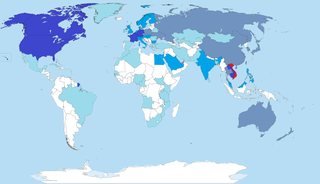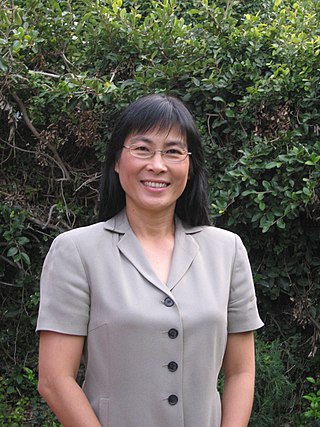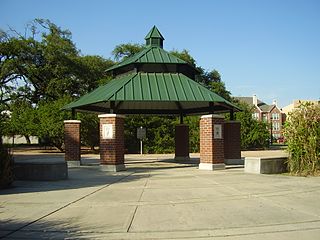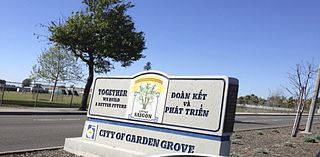Social capital is "the networks of relationships among people who live and work in a particular society, enabling that society to function effectively". It involves the effective functioning of social groups through interpersonal relationships, a shared sense of identity, a shared understanding, shared norms, shared values, trust, cooperation, and reciprocity. Some have described it as a form of capital that produces public goods for a common purpose, although this does not align with how it has been measured.
Acculturation is a process of social, psychological, and cultural change that stems from the balancing of two cultures while adapting to the prevailing culture of the society. Acculturation is a process in which an individual adopts, acquires and adjusts to a new cultural environment as a result of being placed into a new culture, or when another culture is brought to someone. Individuals of a differing culture try to incorporate themselves into the new more prevalent culture by participating in aspects of the more prevalent culture, such as their traditions, but still hold onto their original cultural values and traditions. The effects of acculturation can be seen at multiple levels in both the devotee of the prevailing culture and those who are assimilating into the culture.

Vietnamese Americans are Americans of Vietnamese ancestry. They comprise approximately half of all overseas Vietnamese and are the fourth-largest Asian American ethnic group following Chinese Americans, Indian Americans, and Filipino Americans. There are approximately 2.3 million people of Vietnamese descent residing in the U.S. as of 2023.

Little Saigon is a name given to ethnic enclaves of expatriate Vietnamese mainly in English-speaking countries. Alternate names include Little Vietnam and Little Hanoi, depending on the enclave's political history. To avoid political undertones due to the renaming of Saigon to Ho Chi Minh City, it is occasionally called by the neutral name Vietnamtown. Saigon is the former name of the capital of the former South Vietnam, where a large number of first-generation Vietnamese immigrants emigrating to the United States originate from, whereas Hanoi is the current capital of Vietnam.
Cultural assimilation is the process in which a minority group or culture comes to resemble a society's majority group or assimilates the values, behaviors, and beliefs of another group whether fully or partially.
The term model minority refers to a minority group, defined by factors such as ethnicity, race, or religion, whose members are perceived to be achieving a higher socioeconomic status in comparison to the overall population average. Consequently, these groups are often regarded as a role model or reference group for comparison to external groups (outgroups). This success is typically assessed through metrics including educational attainment, representation within managerial and professional occupations, household income, and various other socioeconomic indicators such as criminal activity and strong family and marital stability. The prominent association of the model minority concept is with Asian Americans within the United States. Additionally, analogous concepts of classism have been observed in numerous European countries, leading to the stereotyping of specific ethnic groups.

In sociology, an ethnic enclave is a geographic area with high ethnic concentration, characteristic cultural identity, and economic activity. The term is usually used to refer to either a residential area or a workspace with a high concentration of ethnic firms. Their success and growth depends on self-sufficiency, and is coupled with economic prosperity.

Overseas Vietnamese refers to Vietnamese people who live outside Vietnam. There are approximately 5 million overseas Vietnamese, the largest community of whom live in the United States.

Cambodian Americans, also Khmer Americans, are Americans of Cambodian or Khmer ancestry. In addition, Cambodian Americans are also Americans with ancestry of other ethnic groups of Cambodia, such as the Chams and Chinese Cambodians.
Social integration is the process during which newcomers or minorities are incorporated into the social structure of the host society.
Carl L. Bankston III is an American sociologist, author and educator. He is best known for his work on immigration to the United States, particularly on the adaptation of Vietnamese American immigrants, and for his work on ethnicity, social capital, sociology of religion and the sociology of education.

Min Zhou is a Chinese-born American sociologist. In 2023, she was elected to the National Academy of Sciences.

The history of immigration to the United States details the movement of people to the United States from the colonial era to the present day. Throughout U.S. history, the country experienced successive waves of immigration, particularly from Europe and later on from Asia and Latin America. Colonial-era immigrants often repaid the cost of transoceanic transportation by becoming indentured servants in which the new employer paid the ship's captain. In the late 19th century, immigration from China and Japan was restricted. In the 1920s, restrictive immigration quotas were imposed but political refugees had special status. Numerical restrictions ended in 1965. In recent years, the largest numbers of immigrants to the United States have come from Asia and Central America.
Mary C. Waters is an American sociologist, demographer and author. She is the John L. Loeb Professor of Sociology and the PVK Professor of Arts and Sciences at Harvard University. Much of her work has focused on immigrants, the meaning of racial and ethnic identity, and how immigrants integrate into a new society. Waters chaired the 2015 National Research Council Panel on The Integration of Immigrants into American Society.
Rubén G. Rumbaut is a prominent Cuban-American sociologist and a leading expert on immigration and refugee resettlement in the United States. He is Distinguished Professor of Sociology at the University of California, Irvine.

This article discusses the history of Vietnamese Americans and Vietnamese immigrants in Houston, Texas, and its environs. Vietnamese immigration has occurred in Greater Houston, including Fort Bend County and Harris County, since 1975, after the Vietnam War ended and refugees began coming to the United States.

Vietnamese has more than 1.5 million speakers in the United States, where it is the sixth-most spoken language. The United States also ranks second among countries and territories with the most Vietnamese speakers, behind Vietnam. The Vietnamese language became prevalent after the conclusion of the Vietnam War in 1975, when many refugees from Vietnam came to the United States. It is used in many aspects of life, including media, commerce, and administration. In several states, it is the third-most spoken language, behind English and Spanish. To maintain the language for later generations, Vietnamese speakers have established many language centers and coordinated with public school systems to teach Vietnamese to students who are born and raised in the United States.
Pyong Gap Min is a sociologist, currently a Distinguished Professor of Sociology at the Graduate Center of the City University of New York and Queens College, City University of New York. He is also the Director of the Research Center for Korean Community at Queens College and a published author. In 2012, he was awarded the Distinguished Career Award by the American Sociological Association.

Looking Like the Enemy: Japanese Mexicans, the Mexican State, and US Hegemony, 1897-1945 is a 2014 non-fiction book by Jerry García, published by The University of Arizona Press. It discusses the treatment of Mexicans of Japanese descent and Japanese nationals in Mexico during World War II, as well as the overall history from 1897 to the war.

Patricia Fernández-Kelly is a social anthropologist, academic and researcher. She is Professor of Sociology and Research Associate at the Office of Population Research at Princeton University. She is also the director of the Princeton Center for Migration and Development, associate director of the Program in American Studies, and Chair of the Board at the Latin American Legal Defense and Education Fund (LALDEF).










